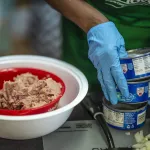FDA Proposes a Helpful New Consumer-Friendly Canned Tuna Label

One of my favorite comfort foods is tuna casserole. Easy. Versatile. Yummy hot or cold. What’s not to like?
That is as long as the tuna to noodles of your choice to veggies or what not are in the proper ratio. Especially the tuna. I’ve learned over the years that just how much tuna resides in any given can is a mystery. The can claims to hold 5 ounces. But that includes the water or vegetable oil.
Once drained … well … it is what it is. I’ve had tuna cans a time or two in my life that held no more than a couple of well rounded tablespoons (yes, I know there are other tuna package options out there).
Which takes me to a shiny new proposal by the Food and Drug Administration that promises a solution to my can conundrum.
As it turns out tuna processors aren’t enamored with current FDA regulations on how tuna is canned. Currently, FDA requires a “pressed cake weight” measurement which was originally designed for three piece cans. No other nation on earth uses the pressed cake weight standard because the three-piece can is obsolete, replaced decades ago by a two-piece model.
Eight years ago, three major tuna producers – Tri Union Seafoods (Chicken of the Sea), Bumble Bee Foods, and StarKist Company – filed a citizen petition with FDA asking the feds to ax the pressed-cake weight standard for a “drained weight” method:
“The pressed cake weight test is an archaic test that is difficult to perform, prone to human error, and produces inconsistent results. It was designed for the old 3-piece cans, not the 2-piece cans that are the industry norm today. The United States is the only country that still uses the pressed cake weight method. The drained weight test is simpler for industry and regulators to perform and produces more consistent, reliable results, thereby ensuring that consumers get the amount of fish they purchase.”
The FDA, being the FDA, took a long time to answer (but that’s another story). But lo and behold late in August, the FDA published in the Federal Register a proposal that not only recommends using a drained weight method but requires tuna can labels to list both net weight and drained weight to give consumers “more complete and useful information about the amount of fish in the can.”
If the FDA rule is finalized as written, it would also likely give consumers new tuna options at the grocery store. FDA proposes clarifying to consumers that canned tuna does not have to be packed in water or vegetable oil. The tuna industry says the clarification will make it easier to offer no drain canned tuna options.
And the tuna might be packed with additional flavorings. FDA proposes “…to allow as optional ingredients any seasonings and flavors that are ‘safe and suitable.’ ”
Needless to say, tuna producers are probably ecstatic. In their citizen petition, the industry said a dry weight method could save packers as much as $15.9 million annually.
FDA is taking public comment through Nov. 24.
Here’s hoping the proposal gets across the finish line. It’s a little thing in the great big scheme of things we deal with day in and day out, but you know consumer labels of all stripes and types should be transparent and clear. And right now, tuna can labels are like swimming through murky waters.
DAVE DICKEY, COLUMNISTCOLUMNIST
dave.dickey@investigatemidwest.org
David Dickey always wanted to be a journalist. After serving tours in the U.S. Marine Corps and U.S. Navy, Dickey enrolled at Rock Valley Junior College in Rockford, Ill., where he was first news editor.
